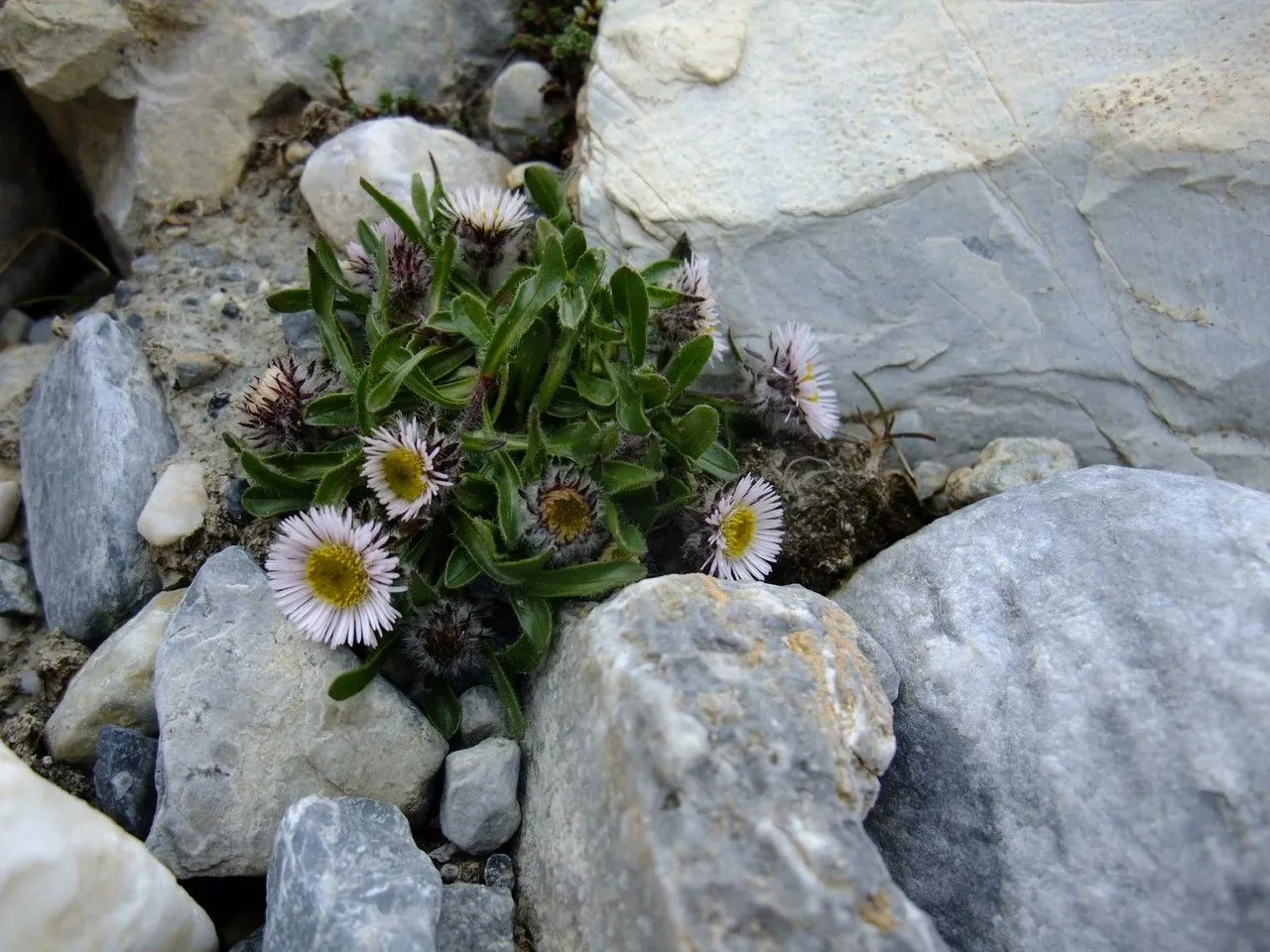
Author: L.
Bibliography: Sp. Pl.: 864 (1753)
Year: 1753
Status: accepted
Rank: species
Genus: Erigeron
Vegetable: False
Observations: Europe to SC. China, New Guinea
Oneflower fleabane, scientifically known as Erigeron uniflorus, is a captivating plant species belonging to the family Asteraceae. First described by the renowned botanist Carl Linnaeus in his seminal work “Species Plantarum” published in 1753, this species has since captured the interest of botanists and plant enthusiasts alike.
This delicate and resilient plant is native to a vast range extending from Europe to South-Central China and even as far as New Guinea. The widespread distribution highlights the plant’s adaptability to different environmental conditions, from the temperate climates of Europe to the more varied climactic regions of New Guinea.
Erigeron uniflorus typically flourishes in alpine meadows and rocky terrains, embodying the hardiness characteristic of many members of the Asteraceae family. The plant is characterized by its singular, charming flowers that bloom with a typically daisy-like appearance, showcasing a central yellow disc surrounded by slender white or occasionally pinkish ray florets. These blooms not only add a splash of color to their natural habitat but also play a crucial role in the local ecosystems, attracting a variety of pollinators including bees and butterflies.
The name “oneflower fleabane” is derived from its singular flowering habit, differentiating it from other species in the genus Erigeron, which often produce multiple blooms. The term “fleabane” has historical roots, as it was once believed that these plants could repel fleas.
In terms of ecological significance, oneflower fleabane thrives in challenging environments, often contributing to the stabilization of soil and prevention of erosion in mountainous areas. This makes it an important species for maintaining the health of habitats where it is found.
In conclusion, Erigeron uniflorus, or oneflower fleabane, is a testament to nature’s diversity and resilience. Its ability to span vast geographic regions while maintaining its unique singular bloom makes it a fascinating subject of study and admiration in the world of botany.
Deu: einköpfiges berufkraut
Swe: fjällbinka, tunturikallioinen
Eng: oneflower fleabane, one-flowered fleabane, northern daisy
Pol: przymiotlo jednokoszyczkowe
Fin: tunturikallioinen
Sme: duottarcammu
Fra: vergerette à une fleur, vergerette à une tête
Lat: erigeron
En: Oneflower fleabane, One-flowered fleabane, Northern daisy, Fleabane
Ar: أريغارون أحادي الزهرة
Ca: Erígeron uniflor
Nl: Eenbloemige Fijnstraal, Eenhoofdige Fijnstraal
Fi: Tunturikallioinen
Fr: Vergerette à une fleur, Vergerette uniflore, Vergerette à une tête
De: Einköpfiges Berufkraut
Is: Fjallakobbi
It: C√©spica uniflora, Cespica uniflora, Céspica uniflora
La: Erigeron
Se: Duottarcammu
No: Snøbakkestjerne
Pl: Przymiotno jednokoszyczkowe, Przymiotlo jednokoszyczkowe
Sk: Turica jednoúborová
Sv: Fjällbinka, Tunturikallioinen
Taken Jul 21, 2017 by Yoan MARTIN (cc-by-sa)
Taken Jul 1, 2016 by Henk Van Lottum (cc-by-sa)
Taken Aug 19, 2021 by Fabien Anthelme (cc-by-sa)
Taken Jun 20, 2019 by garcia (cc-by-sa)
Taken Aug 6, 2021 by Denis Bastianelli (cc-by-sa)
Taken Jul 23, 2020 by Denis Bastianelli (cc-by-sa)
Taken Jul 18, 2010 by Tela Botanica − Yoan MARTIN (cc-by-sa)
Taken Jul 26, 2012 by Tela Botanica − Yoan MARTIN (cc-by-sa)
Taken Jul 9, 2015 by Tela Botanica − Yoan MARTIN (cc-by-sa)
Taken Aug 19, 2021 by Fabien Anthelme (cc-by-sa)
Taken Jul 23, 2020 by Denis Bastianelli (cc-by-sa)
Taken Jul 18, 2014 by Tela Botanica − Hugues TINGUY (cc-by-sa)
Taken Jul 26, 2012 by Tela Botanica − Yoan MARTIN (cc-by-sa)
Taken Jul 23, 2017 by huy HO (cc-by-sa)
Taken Jul 9, 2015 by Tela Botanica − Yoan MARTIN (cc-by-sa)
Taken Jul 1, 2017 by Yoan MARTIN (cc-by-sa)
Taken Jul 1, 2017 by Yoan MARTIN (cc-by-sa)
Taken Jul 23, 2012 by Tela Botanica − Yoan MARTIN (cc-by-sa)
Taken Jul 11, 2012 by Tela Botanica − Yoan MARTIN (cc-by-sa)
Taken Jul 14, 2012 by Tela Botanica − Yoan MARTIN (cc-by-sa)
Taken Aug 18, 2019 by Steve LE BRIQUIR (cc-by-sa)
Taken Jul 1, 2017 by Yoan MARTIN (cc-by-sa)
Taken Jul 22, 2017 by Yoan MARTIN (cc-by-sa)
Taken Aug 14, 2016 by Tela Botanica − Yoan MARTIN (cc-by-sa)
Taken Sep 11, 1995 by Tela Botanica − Liliane ROUBAUDI (cc-by-sa)
Taken Aug 14, 2016 by Tela Botanica − Yoan MARTIN (cc-by-sa)
Taken Sep 11, 1995 by Tela Botanica − Liliane ROUBAUDI (cc-by-sa)
Taken Jul 25, 2022 by noemi (cc-by-sa)
Taken Aug 31, 2019 by W Gunda (cc-by-sa)
Taken Jul 11, 2012 by Tela Botanica − Yoan MARTIN (cc-by-sa)
Taken Sep 10, 1995 by Tela Botanica − Liliane ROUBAUDI (cc-by-sa)
Taken Jul 15, 2014 by Photoflora – Benoit BOCK (©)
Taken Jul 15, 2012 by Photoflora – Benoit BOCK (©)
Taken Jul 15, 2010 by Photoflora – Benoit BOCK (©)
Taken Jan 1, 1970 by Photoflora – L’Abbé COSTE (©)
© copyright of the Board of Trustees of the Royal Botanic Gardens, Kew.
© copyright of the Board of Trustees of the Royal Botanic Gardens, Kew.
© copyright of the Board of Trustees of the Royal Botanic Gardens, Kew.
Growth habit: Forb/herb
Ph maximum: 7.0
Ph minimum: 6.5
Light: 9
Atmospheric humidity: 5
Bloom months: [‘jul’, ‘aug’]
Soil nutriments: 2
Family: Myrtaceae Author: (F.Muell.) K.D.Hill & L.A.S.Johnson Bibliography: Telopea 6: 402 (1995) Year: 1995 Status:…
Family: Rubiaceae Author: Pierre ex A.Froehner Bibliography: Notizbl. Bot. Gart. Berlin-Dahlem 1: 237 (1897) Year:…
Family: Sapindaceae Author: Koidz. Bibliography: J. Coll. Sci. Imp. Univ. Tokyo 32(1): 38 (1911) Year:…
Family: Asteraceae Author: A.Gray Bibliography: Pacif. Railr. Rep.: 107 (1857) Year: 1857 Status: accepted Rank:…
Family: Fabaceae Author: Medik. Bibliography: Vorles. Churpfälz. Phys.-Ökon. Ges. 2: 398 (1787) Year: 1787 Status:…
Family: Aspleniaceae Author: (Cav.) Alston Bibliography: Bull. Misc. Inform. Kew 1932: 309 (1932) Year: 1932…